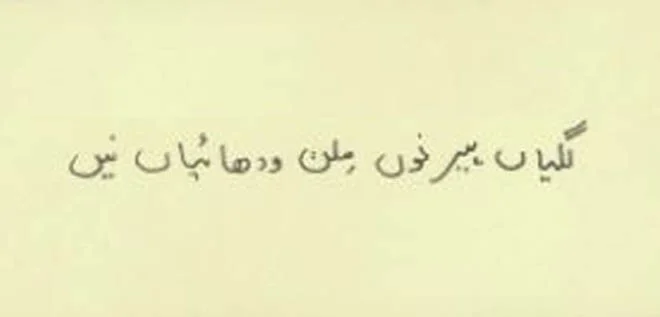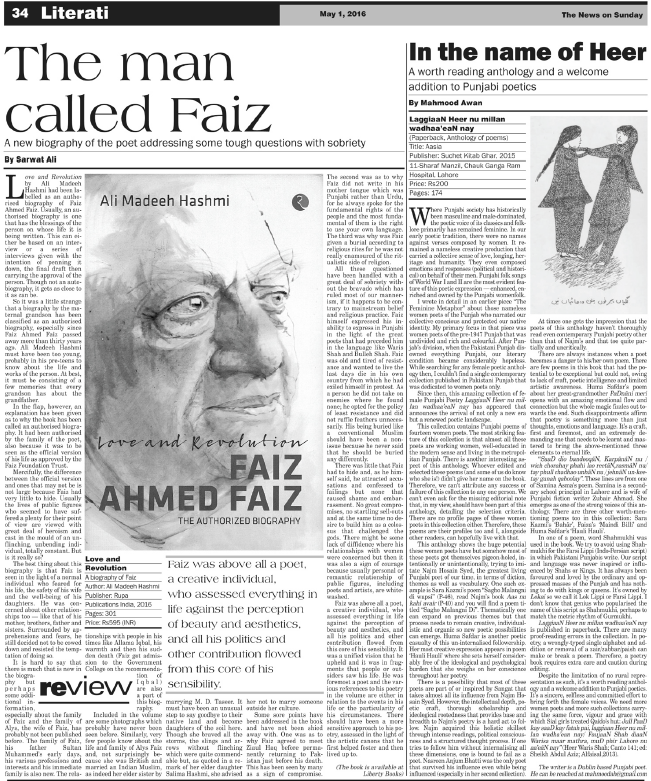Mahmood Awan (The News on Sunday, 1st May 2016)
Where Punjabi society has historically been masculine and male-dominated, the poetic voice of its classics and folklore primarily has remained feminine. In our early poetic tradition, there were no names against verses composed by women. It remained a nameless creative production that carried a collective sense of love, longing, heritage and humanity. They even composed emotions and responses (political and historical) on behalf of their men. Punjabi folk songs of World War I and II are the most evident feature of this poetic expression — enhanced, enriched and owned by the Punjabi womenfolk.
I wrote in detail in an earlier piece “The Feminine Metaphor” about those nameless women poets of the Punjab who narrated our collective conscious and protected our native identity. My primary focus in that piece was women poets of the pre-1947 Punjab that was undivided and rich and colourful. After Punjab’s division, when the Pakistani Punjab disowned everything Punjabi, our literary condition became considerably hopeless. While searching for any female poetic anthology then, I couldn’t find a single contemporary collection published in Pakistani Punjab that was dedicated to women poets only.
Since then, this amazing collection of female Punjabi Poetry LaggiaaN Heer nu millan wadhaa’eaN nay has appeared that announces the arrival of not only a new era but a renewed poetic landscape.
This collection contains Punjabi poems of fourteen women poets. The most striking feature of this collection is that almost all these poets are working women, well-educated in the modern sense and living in the metropolitan Punjab. There is another interesting aspect of this anthology. Whoever edited and selected these poems (and some of us do know who she is!) didn’t give her name on the book. Therefore, we can’t attribute any success or failure of this collection to any one person. We can’t even ask for the missing editorial note that, in my view, should have been part of this anthology, detailing the selection criteria. There are no profile pages of these women poets in this collection either. Therefore, these poems are their profiles too and I, alongside other readers, can hopefully live with that.
This anthology shows the huge potential these women poets have but somehow most of these poets got themselves pigeon-holed, intentionally or unintentionally, trying to imitate Najm Hosain Syed, the greatest living Punjabi poet of our time, in terms of diction, themes as well as vocabulary. One such example is Sara Kazmi’s poem “Sagho Malangni di wapsi” (P-46), read Najm’s book Aas nu kahi avair (P-40) and you will find a poem titled “Sagho Malangni Di”. Thematically one can expand on previous themes but that process needs to remain creative, individualistic and organic so new poetic possibilities can emerge. Huma Safdar is another poetic casualty of this un-internalised followership. Her most creative expression appears in poem ‘Hauli Hauli’ where she sets herself considerably free of the ideological and psychological burden that she weighs on her conscience throughout her poetry.
There is a possibility that most of these poets are part of or inspired by Sangat that takes almost all its influence from Najm Hosain Syed. However, the intellectual depth, poetic craft, thorough scholarship and ideological rootedness that provides base and breadth to Najm’s poetry is a hard act to follow. Najm acquired this holistic skillset through intense readings, political consciousness and a structured thought process. If one tries to follow him without internalising all these dimensions, one is bound to fail as a poet. Nasreen Anjum Bhatti was the only poet that survived his influence even while being influenced (especially in her second collection).
At times one gets the impression that the poets of this anthology haven’t thoroughly read even contemporary Punjabi poetry other than that of Najm’s and that too quite partially and uncritically.
There are always instances when a poet becomes a danger to his/her own poem. There are few poems in this book that had the potential to be exceptional but could not, owing to lack of craft, poetic intelligence and limited artistic awareness. Huma Safdar’s poem about her great-grandmother PaDnãni meri opens with an amazing emotional flow and connection but the whole magic fizzles out towards the end. Such disappointments affirm that poetry is something more than just thoughts, emotions and language. It’s a craft, first and foremost, and an extremely demanding one that needs to be learnt and mastered to bring the above-mentioned three elements to eternal life.
“SaaD dio bandooqãN, KarpãnãN nu / wich chorahay phahi lao reetãN,rasmãN nu/ tay phull chadhao unhãN nu / jehnãN un-keetay gunah qaboolay”. These lines are from one of Samina Asma’s poem. Samina is a secondary school principal in Lahore and is wife of Punjabi fiction writer Zubair Ahmad. She emerges as one of the strong voices of this anthology. There are three other worth-mentioning poems too in this collection: Sara Kazmi’s ‘Bahãr’, Faiza’s ‘Maindi Billi’ and Huma Safdar’s ‘Hauli Hauli’.
In one of a poem, word Shahmukhi was used in the book. We try to avoid using Shahmukhi for the Farsi Lippi (Indo-Persian script) in which Pakistani Punjabis write. Our script and language was never inspired or influenced by Shahs or Kings. It has always been favoured and loved by the ordinary and oppressed masses of the Punjab and has nothing to do with kings or queens. It’s owned by Lokai so we call it Lok Lippi or Farsi Lippi. I don’t know that genius who popularised the name of this script as Shahmukhi, perhaps to match the metric rhythm of Gurmukhi.
LaggiaaN Heer nu millan wadhaa’eaN nay is published in paperback. There are many proof-reading errors in the collection. In poetry, a wrongly-typed single alphabet and addition or removal of a zair/zabbar/paish can make or break a poem. Therefore, a poetry book requires extra care and caution during editing.
Despite the limitation of no rural representation as such, it’s a worth reading anthology and a welcome addition to Punjabi poetics. It’s a sincere, selfless and committed effort to bring forth the female voices. We need more women poets and more such collections carrying the same force, vigour and grace with which Sial girls treated Qaido’s hut: Jull PaaD kay saaD kay fatah pai, laggiaan Heer nu millan wadha’ean nay/ FaujaaN Shah diaaN Warisa maar mathra, muD phir Lahore nu aa’eãN nay” (Heer Waris Shah; Canto 141; ed: Sheikh Abdul Aziz; Alfaisal,2013).
LaggiaaN Heer nu millan wadhaa’eaN nay
(Paperback, Anthology of poems)
Title: Aasia
Publisher: Suchet Kitab Ghar, 2015 11-Sharaf Manzil, Chauk Ganga Ram Hospital, Lahore
Price: Rs200
Pages: 174
Published on 1st May 2016 in The News on Sunday.
https://www.thenews.com.pk/tns/detail/560863-name-heer


